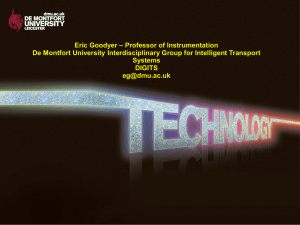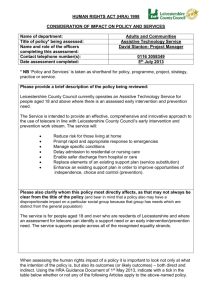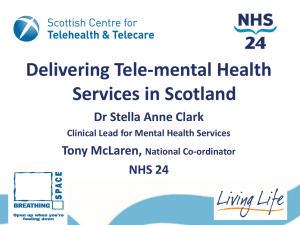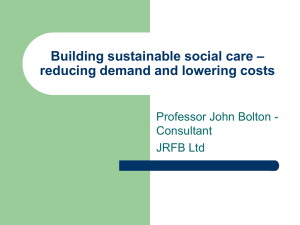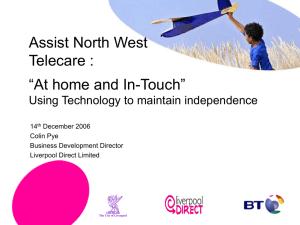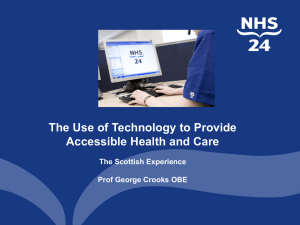Technology and Older People Evidence Review
advertisement
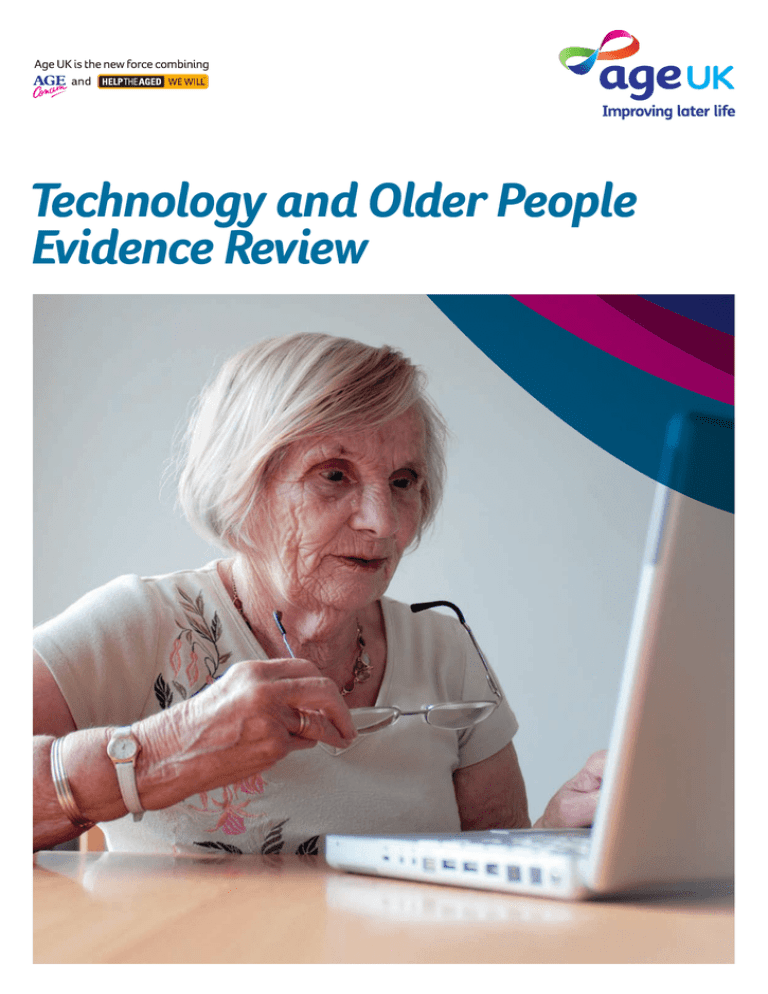
Technology and Older People Evidence Review This evidence review is part of a series produced by Age UK, in order to provide evidence to underpin decision-making for people involved in commissioning, service development, fundraising and influencing. Contents Key messages 3 1 Policy context 4 2 The benefits and limitations of technology for the older population 7 a) Reducing loneliness and isolation 7 b) Being in control 7 c) Living independently 8 d) Participating and contributing 11 3 Services that enable the use of technology 12 Notes16 Technology and Older People Evidence Review 1 Key messages From the evidence presented below, we can say the following. • Most studies of older people’s involvement with technology focus on the internet. • Fewer people aged 65+ have access to the internet than younger age groups, but numbers are increasing rapidly. • Despite barriers, such as cost, the userfriendliness (or the lack of it) of equipment and unfamiliarity/resistance to change, many older people already benefit from new technologies. • The main functions used are those enabling them to keep in touch regularly and relatively cheaply with family and friends. • Older people who do have home access use the internet more than other age groups. • The use of technology for enabling social contact and participation can be very successful, but many older people need help at the start and some need ongoing support or reassurance. • Many websites are poorly designed and are not fully accessible to older users. • Older people (65+) are increasingly accessing information and advice, goods and services via the internet. • There are reasons other than cost-saving for technological solutions to help older people remain independent in their own homes, including assistance with everyday tasks compensating for lost physical and cognitive function. • Technology can also be successfully used for monitoring older people remotely, but this works best with the older (potential) beneficiaries’ informed consent and active participation. • Older people’s involvement with telecare and remote health monitoring are best achieved when the technology is simple and designed for the beneficiary to understand and to use. Notes 1 The focus of this evidence review is on the use of technology by older people or for their immediate benefit. 2 Technology has been defined for this purpose as equipment – or facilities delivered by equipment – not previously familiar in the everyday life of the older population in general. The majority of technologies reviewed here are delivered via the internet. 3 Because of the fast-moving nature of technology, a large body of research has been rejected because the results may no longer apply. For example, a 2000 MORI study showed an older population almost entirely without the equipment, skills and motivation to use internet and allied technologies, whereas more recent research presents a different picture. Technology and Older People Evidence Review 3 1 Policy context Currently, 6 million older people have never used the internet.1 Three million older people (36 per cent) feel out of touch with the fast pace of modern life.2 The fast-changing pace of technology and its integration and application to living everyday life means that it is no longer an optional extra but fast becoming recognised as a basic human right, as argued in recent court proceedings in France. A Consortium for the Promotion of Digital Participation to drive digital participation is in place. The Consortium will play a key role in delivering a national plan for digital participation, which will include a social marketing programme that will promote the benefits of being online and an outreach programme to help get the hard-to-reach connected, currently being piloted by Digital Outreach Limited. According to Lord Carter, Minister for Communications, Technology and Broadcasting 2008–09, digital inclusion should provide a range of benefits: Informal learning opportunities for adults The best use of digital technology, either directly or indirectly to improve the lives and life chances of all citizens, particularly the most disadvantaged, and the places in which they live.3 Digital Britain White Paper Some of the key policies from the Digital Britain White Paper that impact older people include the Government’s commitment to ensure universal broadband access. This will address the underlying infrastructure issues that prevent about 4 per cent of the country accessing broadband, and the recognition that the skills, motivation and cost issues go together with the accessibility issue. As a result of the Digital Britain White Paper, an announcement has been made for a last third fund for Next Generation Access (NGA). The fund will help uneconomic areas get access to superfast broadband. The intention is that this broadband will deliver public and private services. 4 Technology and Older People Evidence Review In March 2009 the Secretary of State for Innovation, Universities and Skills published The Learning Revolution, a White Paper on informal adult learning. The White Paper identified technology and broadcasting as key enablers. A number of proposals have come about as a result of the White Paper, which includes an independent review of ICT skills for adults undertaken by Estelle Morris. This review was published alongside the Digital Britain White Paper in June 2009. This recommended that adults should be given an ‘entitlement’ to access provision and support to learn the basic skills they need to get online. In response, the Government will pilot Online Basics in January 2010. The Government will consider the next steps for Online Basics following an evaluation of the pilot and the agreement of priorities within the Skills Investment Strategy. Building a Society for All Ages Under the Building a Society for All Ages banner, a range of digital inclusion initiatives are intended to give the 600,000 people living in sheltered housing access to new technology, along with the necessary support and mentoring. The UK Government has signed up to the Riga Ministerial Declaration on ICT for an inclusive society, thereby committing to halve the gap in internet usage by 2010 for groups at risk of exclusion, with particular emphasis on older people.4 This continued prioritisation of technology and ageing at a European level has also resulted in an action plan being published on Ageing Well in the Information Society. The action plan aims to improve the lives of older people: to help them continue living independently at home, in the workplace and in society in general. The UK is set to miss these targets, which has prompted the Government, in part, to appoint the first Minister with responsibility for digital inclusion – the right honourable Paul Murphy. The European Commission has further adopted an Action Plan on ICT for Ageing Well in the Information Society aimed at raising awareness of the market and individual opportunities from ICT. The Action Plan is focusing on ageing well, promoting the enabling conditions of technologies for employment, fostering uptake for these technologies, and encouraging research in this area. Technology for health and social care The UK Government has consistently shown that it believes that technology is an integral part of the future of health and social care, talking of its ability to reduce waiting times, prevent avoidable admission to acute services and support hospital discharge. A report by the Health Select Committee in 2002 called for the Department of Health to establish ‘a national strategy to promote the systematic development of telecare solutions as part of a spectrum of care at home’. It also called for the Government to examine ways of facilitating greater uptake of telehealth solutions within both health and social care’. The Department of Health further published its vision for health and social care in 2005. It noted that telecare has huge potential to support individuals to live at home, and to complement traditional care. It can give carers more personal freedom and more time to concentrate on the human aspects of care and support and will make a contribution to meeting potential shortfalls in the workforce. The Government then committed £80 million over two years to a Preventative Technologies Grant programme. However, as the money was not ring-fenced, the money spent often failed to deliver the expected outcomes. Most recently, the Government has committed an additional £80 million of funding to roll out three preventive technologies whole system demonstrator sites in Kent, Newham and Cornwall. These sites will support over 7,500 people with long-term care needs over the next two years. It remains to be seen if this will bear out the findings of large-scale trials, which have demonstrated that providing assistive technology at home along with home care support, as an alternative to residential care, can more than halve the average stay in residential care for many people. This initiative aims not only to enhance older people’s choice and independence, but also to have a positive budgetary impact: delaying admission to residential care by one year saves an average of £26,000 per person compared to the average cost of basic housing adaptations and telecare solutions of £6,000.5 Technology and Older People Evidence Review 5 2 The benefits and limitations of technology for the older population a) Reducing loneliness and isolation There is clear evidence that the use of modern technologies, particularly the internet, as a method for establishing and maintaining social contact is on the increase among the older population. Although exclusion from technology increases with age, the pattern both of access and use is changing appreciably year by year, especially now that those retiring are more likely to have used information and contact technology as part of their jobs. For many of those who have home access (or access in a public place, such as a library), email and social networking sites are becoming as useful a means of keeping in touch with family and friends as the telephone. (For a full account of the key role of telephone contact as a means of combating loneliness, please see Isolation and Loneliness Evidence Review. Forty per cent of the 65+ age group in the UK in 2010 have never used the internet. This equates to approximately 4 million people. The over-65s are still less likely than other age groups to have ever used the internet, but the number of people aged 65+ who are using the internet is rising more rapidly than any other age group – from 30 per cent in 2008 to 36 per cent in 2009. Where people in later life have access to the internet, 59 per cent of people aged 65+ use it every day.6 Active internet users aged 65 and above spend on average almost 42 hours online every month – more than any other age group.7 Thirty-two per cent of all adults aged 65 or over (about 3.2 million) have used the internet in the last three months, compared to 72 per cent of 55–64-year-olds and an all-age average of 77 per cent. The 65+ figure is rising fastest in this category (from 26 per cent in the last three years). The lower 65+ figure partly reflects the fact that fewer in this age group have access at the workplace.8 Encouraged by national social marketing events and campaigns such as Digital Unite’s Silver Surfer day, UK online’s ‘It’s Never too Late’ (linked with Silver Surfer Day in 2009), National Adult Learner’s Week and Age UK’s itea and biscuits and myfriends online weeks, increasing numbers of older people are using social networking websites, Skype and other internet-based contact technology. b) Being in control The older population (particularly those aged 65+) is increasingly using modern technologies, particularly the internet, for functions other than maintaining social contact. The most recent Office for National Statistics report shows a trend towards more functional tasks. For the older age groups (55–64 and 65+), the most common uses of the internet are sending/receiving emails, finding information and using services for travel and accommodation. Fifty-two per cent of people aged 55–64 in the UK purchased goods over the internet in the last year, compared to 22 per cent of people aged 65+. The rise since 2008 is higher in these older age groups than the average.9 For the 65+ age group, the main purchases included holiday accommodation (44 per cent), books, magazines, newspapers (40 per cent), clothes and sports goods (38 per cent), and household goods (37 per cent). Also prominent for older age groups was travel arrangements (transport, tickets, car hire). Twenty per cent of people aged 65+ downloaded films and music from the internet, rather than ordering them by post, in the last 12 months. Fifteen per cent of people aged 65+ did so for ebooks, newspapers, magazines and learning materials. Technology and Older People Evidence Review 7 Access to information and advice via government websites still needs to be properly analysed and evaluated by age. Although it is still too early for a detailed evaluation of the Age UK website, visitors to the old Age Concern website, particularly those looking up information and advice (see Information and Advice for Older People Evidence Review), were predominantly older. A survey of users of the Age Concern website found that 65 per cent of website users were over 50 years old, while 30 per cent were between 60 and 70 years old.10 c) Living independently The focus for the use of technology to facilitate older people to live independently in their own homes for longer has been on additional, assistive technology and telecare/telehealth. Other possible solutions, such as designing lifetime homes11 and specially designed new housing, such as the West Bromwich pilot ‘i-house’,12 fall beyond the remit of this review. Assistive technology, health and social care Assistive technology has been defined as: an umbrella term for any device or system that allows an individual to perform a task they would otherwise be unable to do or increases the ease and safety with which the task can be performed.’13 any product or service designed to enable independence for disabled and older people.’14 8 Technology and Older People Evidence Review Assistive technology incorporates a wide variety of devices, and some of these might further be categorised as providing either ‘telecare‘ or ‘telehealth‘. These terms indicate the use of technology to provide care and health services (respectively) at a distance. Pollack (2005) studied the effectiveness of IT-based assistive technology on combating cognitive impairment in older people in the USA and found that it can be of use: ‘in one or more of the following ways: 1 By providing assurance that the elder is safe and is performing necessary daily activities and, if not, alerting a caregiver 2 By helping the elder compensate for her impairment, assisting in the performance of daily activities; and 3 By assessing the elder’s cognitive status.15 Pollack goes on to list, in addition to remote monitoring, some of the specific uses of artificial intelligence for older people with cognitive impairment themselves. These include reassurance, location (reminding people where they are and where they were intending to go) and compensation (fulfilling functions, specifically memory-related), all of which the beneficiary may find difficult. As with other studies of this date, technological solutions are based on telephone access (as with Aid Call) rather than a dedicated internet connection. Types of telecare Community alarms There are sometimes considered to be three ‘generations’ of telecare. Different estimates suggest that there are between 1.3 and 1.5 million people in the UK linked to a community alarm service.21 In Scotland in 2006, over 137,000 people were using community alarms.22 • First generation: User-activated community alarms (social alarms). • Second generation: Home monitors – sensors that monitor the home environment, vital signs and physiological measures. These are typically linked to a monitoring centre. • Third generation: The use of communications technology (broadband, wireless, audiovisual) to allow virtual or tele-consultations between the service user and doctor, nurse or support worker.16 Telehealth has been defined as the remote monitoring of vital signs that medical professionals can use for diagnosis and prevention,17 or as the delivery of health services and clinical monitoring at a distance through use of telecommunications, sensors and computers.18 The uncertain overlap between telecare and telehealth has been noted. One 2005 publication states: ‘Rapid technological development is already blurring boundaries between telecare, telehealth, social alarms, electronic medicines management and environmental controls.’19 There were nearly 150,000 new telecare users in England in 2006–07 and 161,000 in 2007–08. Over the same period, total expenditure on telecare came to £132 million. By 2009 it is expected that 45,000 people in Wales, or 1.5 per cent of its total population, will be using a telecare service other than a community alarm, following the Telecare Capital Grant of £9 million from 2006–09.20 Help with independent living Different estimates suggest that 80 per cent23 or 90 per cent24 of older people want to live in their own homes. Department of Health research from 2005 or earlier, suggested that telecare could support up to 35 per cent of care home residents to live at home or in extra-care housing schemes.25 In Scotland, by September 2007, Telecare Development Programme funding was responsible for allowing at least 1,300 people to continue living at home, avoiding 74 care home admissions and saving 6,900 care home beds.26 A telecare pilot in West Lothian resulted in the average length of care-home stay being more than halved, from three years in 2000 to 16 months in 2005.27 It was estimated (based on evidence from US studies) that in 2004, telecare could help reduce the average length of hospital stay in patients aged 70+ by between 20 per cent and 60 per cent. In one study (of over 100 users), average hospital in-patient days fell from 9.2 to 5.7.28 A telecare pilot in West Lothian resulted in a delayed discharge rate in the region of 1.4 per 1,000, as opposed to a Scotland average of 2.7 per 1,000. Mean length of hospital stay was 30 days, as opposed to the Scotland average of 112 days.29 Technology and Older People Evidence Review 9 Reassurance In a Kent pilot study of telecare, mostly of home monitors and sensors, users (who were not all older people – no age breakdown is available) typically felt it gave them reassurance and increased confidence. Ninety-three out of 100 users surveyed said that they felt much safer with telecare. Telecare was also found to reduce carers’ anxiety.30 Independence In the Kent pilot study, 84 out of 100 users surveyed felt they could live more independently with telecare.31 A 2002 study of people with dementia (in Northampton) found no evidence of service users regaining independence through telecare. However, for some, it helped to maintain independence.32 In the Kent pilot study, some users felt that telecare prevented or reduced falls, or averted hospital stays or moves.33 A 2005 study found that the extent of ‘felt need’ influences the extent to which users perceive telecare as acceptable or useful.34 It has been noted (by the same 2005 study) that if telecare requires home modification, this can alter service users’ sense of the home environment.35 To quote a 2006 publication: ‘When unwelcome adaptations are installed in the home, recipients can feel helpless and disempowered.’36 10 Technology and Older People Evidence Review Ease of use and the active involvement of the older user are elements stressed by research. Reina-Tosina et al, (2001) outline the role of the service users themselves and the need for them to understand the workings of a ‘home health telecare’ pilot project in Spain. A clear challenge of any product for home telecare is to make usage as easy as possible. The less people need to learn about how to use the equipment, the more likely they are to feel secure and comfortable when they use it at home.37 Concerns have been raised over the potential intrusiveness of home-monitoring systems. An issue has been raised of an ethical dilemma between balancing clients’ potential wishes to be left alone, and the knowledge of the benefits that telecare services could provide them.38 However, it has also been acknowledged that telecare could serve to increase service users’ privacy, by being able to provide assistance with personal care that would otherwise have to be provided by carers.39 Consensus is that telecare is not a panacea,40 and that it should be an addition to person-provided care rather than a replacement for it. One publication suggests: ‘The role of technology is not to replace personal contact, but to substitute low-input visits with high-quality contact experiences.’ 41 A 2005 publication similarly suggests that telecare cannot deliver care, but can ‘free human carers to make better-quality interventions.’42 d) Participating and contributing Motivation Although there is a dearth of evidence concerning the contribution of older users of technology, there is a body of knowledge on the factors that influence older people’s effective use of these technologies, especially the internet. The specific barriers are lack of access, interest or motivation, and the necessary skills to make use of what is on offer. There can be a lack of interest and perceived benefit. Large numbers of people report that the reason they do not use the internet and other technologies is that they have no need for it, or no interest. This is largely because technology suppliers often use jargon when describing their products, making it difficult for older people to identify the benefits. Access Affordability of equipment or usage – even though technology prices are dropping, cost and the need to sign up to a contract demanding regular payment remain significant barriers for some older people. Pricing structures, as well as price itself, has an effect on take-up. Lack of accessibility is another problem. Technology provides additional barriers for people who have disabilities (including poor vision, or lack of dexterity). Recent research published by the University of Ulster concluded that poor website design often contributed to difficulties faced by older internet users, with 55 per cent of the websites investigated not meeting even the most basic standards of usability and comprehensibility.43 Yet simple adaptations to IT materials and websites can have a marked improvement on accessibility and usability. A recent SPARC (Strategic Promotion of Ageing Research Capacity) report found that: ‘By using targets which expanded to a larger size, giving the user a larger area to click on, users were able to “point and click” faster and make fewer mistakes.’44 Skills and confidence The rapid progression of technology can result in the need for ongoing support and there can also be concerns about viruses, privacy and fraud. A lack of confidence can be a problem among older people who do not have immediate family or friends who effectively engage with technology, and so do not get the help and guidance that many new users find valuable.46 Institutional learning environments are also not appropriate for older people and detract from, rather than build up, their confidence. For a fuller review of the literature, see Older People’s Engagement with ICT.45 Technology and Older People Evidence Review 11 3 Services that enable the use of technology National activity has generally focused on social marketing events and campaigns such as Digital Unite’s Silver Surfer day, UK online’s ‘Its Never too Late’ (linked with silver surfer day in 2009), National Adult Learner’s week and Age UK’s itea and biscuits and myfriends online weeks. All these campaigns aim to address the issues of interest and motivation for digital participation among older people and provide opportunities for older people to get a taste of technology in a friendly and informal setting. This model of delivery and the key campaign messaging have proved to be very successful, attracting millions of people through media coverage to thousands of events every year.47 Since 2007, Age Concern Edinburgh has been running the Moose in the Hoose Project, aimed at introducing the benefits of computers and the internet to those living in care homes and attending day care centres across Edinburgh. The project provides long-term, sustainable access by utilising the time, skills and commitment of older volunteers to support learners. The service currently has 24 friendly and specially trained volunteers maintaining weekly visits to care homes and centres. It also assists homes and centres to establish and maintain an environment where electronic communication and IT are readily accessible and well-supported. The project won the City of Edinburgh Council Get Up and Go Award in 2009 in recognition of its contribution towards improving opportunities and services for older people and reducing age discrimination so that Edinburgh can truly become A City for all Ages. 12 Technology and Older People Evidence Review Citizens Online’s EverybodyOnline Programme has been running since 2002 and has involved the creation of 23 projects covering England, Scotland, Northern Ireland and Wales. The EverybodyOnline Northern Ireland programme running from 2003 to 2006 focused on older people (at home and in residential settings), people with disabilities, and those living in the remote areas of the North West, Fermanagh and South Tyrone. More than 22,000 people attended internet taster sessions and internet and email workshops as part of the programme. Eighty-five sheltered housing schemes for older people across Northern Ireland are now online, providing free internet access to over 4,000 tenants and staff.48 The programme was able to deliver these results by: • employing two EverybodyOnline Project Officers and embedding them into the community, to help older people living in their own homes and in sheltered accommodation to overcome barriers to technology and to use it in a meaningful way • working with five sheltered housing providers in Northern Ireland to get computers and broadband connections installed into sheltered-housing schemes’ common rooms for older people across the province • developing a network of volunteers to show older people how to use the internet • providing free training materials and packs developed specifically for older people • delivering tailored training to sheltered housing scheme staff to ensure that they had the skills to support tenants when using the internet in the schemes’ common rooms. The Connecting Milton Keynes project provides a great example of a local government response to two of the key barriers to digital participation – access and affordability. Milton Keynes Council and Microsoft teamed up to provide a low-cost computer loan scheme (£2.00 per week) to residents who, for all manner of reasons, cannot afford either the hardware or the costs of training and support needed to use a PC or laptop at home. The schemes grew from government research, which highlighted a strong link between home access to a PC and economic prosperity, employment prospects and educational attainment.49 The scheme received international recognition when it was recently presented with an e-inclusion award at a European ministerial conference in Vienna. Digital Birmingham’s Keeping IT in the Family uses an intergenerational approach to digital inclusion to support informal learning in the home. The project has developed a comic-style resource, designed to engage young people, particularly school-aged children, to help learn and share important IT skills with their families. Keeping IT in the Family was originally developed as a pilot with Microsoft. However, the pilot proved so successful that it attracted subsequent funding from BECTA, which has enabled the development of a second series. This second series builds upon the basic IT skills gained from the first, and moves the family on to use these new skills to get the most from digital technologies. Keeping IT in the Family 2 was rolled out to 26 schools participating in the Computers for Pupils initiative, as well as being launched on Silver Surfers Day May 2009 at Acocks Green Library as part of its Wired up to Wellbeing – help with IT for over-60s’ sessions.50 An intergenerational approach to digital inclusion is a common theme. A further example is the BT Internet Rangers project, which is dedicated to supporting and recognising all of the young people helping to bridge the digital divide by using their skills to teach the older generation how to get online.51 14 Technology and Older People Evidence Review There is significant current interest in targeted programmes for older people living in sheltered housing. At the 2010 National Digital Participation Conference in March, this issue was voted as one of the top four priorities. Get Digital was a new scheme in 2010 that aims to get 20,000 older people in sheltered housing online by March 2011. The project is being delivered by Digital Unite and National Institute of Adult Continuing Education (NIACE) and will work with housing residents, staff and the wider community, including local schools, to promote, deliver and sustain digital literacy skills.52 The scheme also has a specific focus on engaging with older people in sheltered housing schemes in rural areas where the costs of digital participation are higher. In 2009 Media Trust won a bid to deliver the Government’s Digital Mentor Programme worth £900,000. In June 2009, the programme was launched as Community Voices and focused on working in deprived communities in England to help more individuals to use social and community media. The project, which is aimed at all social and digital excluded groups, focuses on increasing the skills of individuals in using websites, podcasts, digital photography, online publishing tools and local broadcast media. Communities and local government wish to: • empower individuals and communities by giving those citizens, who feel ‘voiceless’ or ‘unheard’, new tools to express their views and collaborate on issues of relevance to them • provide informal and formal learning opportunities and assist people into employment, particularly in the creative industries • improve access to public and other services.53 Notes 1 Internet Access 2010 Households and Individuals, ONS, 2010 29 Telecare and Older People (Wanless Social Care Review), King’s Fund, 2006 2GfK NOP Help Unite Generations survey for Help the Aged, 2005 30 Piloting Telecare in Kent County Council: The key lessons – final report 2006, Centre for Health Services Studies, 2006 3The Digital Inclusion Taskforce homepage www.21stcenturychallenges. org/focus/the-digital-inclusion-task-force/ 4European Commission, Riga Ministerial Declaration on e-Inclusion, 2006, http://ec.europa.eu/information_society/activities/einclusion/events/ riga_2006/index_en.htm The Safe at Home Project: Using technology to support the care of 32 people with dementia in their own homes, John Woolham et al. 2002 5Help the Aged, Assistive Technology: Policy Position, 2007, http://policy. helptheaged.org.uk/_policy/Poverty/Technology/_default.htm Piloting Telecare in Kent County Council: The key lessons – 33 final report 2006, Centre for Health Services Studies, 2006 6 Internet Access 2010 Households and Individuals, ONS, August 2010 The Acceptability of Assistive Technology to Older People, 34 Claudine McCreadie and Anthea Tinker, 2005 7 The Communications Market 2007, Ofcom, 2007 8 Internet Access 2010 Households and Individuals, ONS 2010 9 Internet Access 2010 Households and Individuals, ONS 2010 10Internet survey Age Concern (unpublished) 11See Delivering Lifetime Homes, Lifetime Neighbourhoods, A National Strategy for Housing in an Ageing Society, CLG 2008 12See the 2008 article www.bjhcim.co.uk/news/2008/n805028.htm 13‘The Role of Assistive Technology in Alternative Models of Care for Older People’, Donna Cowan and Alan Turner-Smith, in Royal Commission on Long Term Care (Research Volume 2), Anthea Tinker et al. 1999 14King’s Fund definition of 2001, quoted in: Assistive Technology and Older People (research briefing), Social Care Institute for Excellence, 2008 Intelligent technology for an aging population. The use of AI to assist 15 elders with cognitive impairment, M. Pollack M, AIMag, vol 26, (2) Summer 2005 www.aaai.org/ojs/index.php/aimagazine/article/view/1810/1708 Telecare in Scotland: Benchmarking the present, embracing the future, 16 Joint Improvement Team, 2008; Telecare Implementation Guide, Care Services Improvement Partnership, 2005; and Piloting Telecare in Kent County Council: The key lessons – final report 2006, Centre for Health Services Studies, 2006 Telecare and Older People (Wanless Social Care Review), King’s Fund, 2006 17 18 Evidence submitted to the Older People’s Inquiry into ‘That Bit of Help’, Joseph Rowntree Foundation, 2006 Telecare Implementation Guide, Care Services Improvement 19 Partnership, 2005 Telecare in Scotland: Benchmarking the present, embracing the future, 20 Joint Improvement Team, 2008 Telecare and Older People (Wanless Social Care Review), King’s Fund, 21 2006 (estimate of 1.5m); The Acceptability of Assistive Technology to Older People, Claudine McCreadie and Anthea Tinker, 2005 (1.3m); and Building Telecare in England, Department of Health, 2005 (1.4m) Telecare in Scotland: Benchmarking the present,embracing thefuture, Joint 22 Improvement Team, 2008 Assistive Technology: Independence and well-being 4, 23 Audit Commission, 2004 Building Telecare in England, Department of Health, 2005 24 25 Building Telecare in England, Department of Health, 2005 26 Telecare in Scotland: Benchmarking the present, embracing the future, Joint Improvement Team, 2008 Telecare and Older People (Wanless Social Care Review), King’s Fund, 2006 27 28 Assistive Technology: Independence and well-being 4, Audit Commission, 2004 16 Piloting Telecare in Kent County Council: The key lessons – 31 final report 2006, Centre for Health Services Studies, 2006 Technology and Older People Evidence Review 35 The Acceptability of Assistive Technology to Older People, Claudine McCreadie and Anthea Tinker, 2005 Evidence Submitted to the Older People’s Inquiry into ‘That Bit of Help’, 36 Joseph Rowntree Foundation, 2006 Home Health Telecare and the Elderly in Spain: Technologies involved and 37 methodological issues, J. Reina-Tosina et al., Proceedings – 23rd Annual Conference – IEEE/EMBS 25-28 October, 2001, Istanbul Turkey www.dtic. mil/cgibin/GetTRDoc?Location=U2&doc=GetTRDoc.pdf&AD=ADA411744 Assistive Technology and Older People (research briefing), Social Care 38 Institute for Excellence, 2008 Evidence Submitted to the Older People’s Inquiry into ‘That Bit of Help’, 39 Joseph Rowntree Foundation, 2006 40Telecare and Older People (Wanless Social Care Review), King’s Fund, 2006 41 Telecare Implementation Guide, Care Services Improvement Partnership, 2005 42‘Concept Before Construction’, Nigel Appleton, in Futurecare@home: A collection of papers for the Housing Learning & Improvement Network, Department of Health, 2005 Investigating the Problems Faced by Older Adults and People with 43 Disabilities in Online Environments. K. Curran. et al. Behaviour & Information Technology, 26 (6), November–December 2007: 447–453 44Improving Computer Interaction for Older Users: Using dynamic on-screen targets, executive summary. F. Hwang. et al. SPARC website www.sparc. ac.uk/media/downloads/executivesummaries/exec_summary_hwang.pdf 45‘Literature Review Older People’s Engagement with ICT’ November 2008 (unpublished) 46‘Does the Internet Help to Overcome Social Exclusion?’ P. Foley. et al. 2004, www.ejeg.com/volume-2/volume2-issue2/v2-i2-foley-pp139-146.pdf 47‘Review of Silver Surfer Day’ (July 2009) Digital Unite, http://dnc. digitalunite.com/files/2009/07/ssd09standalone_summary_final.pdf 48‘Working at Grassroots to Close the Digital Divide: Northern Ireland Project Review’ (April 2009) Citizens online www.citizensonline.org.uk/site/media/ documents/2341_EOL_NI_3_YearReport_2009.pdf 49www.connectmk.com/AboutUs.aspx 50www.digitalbirmingham.co.uk/projects/keeping-it-in-the-family 51www.btinternetrangers.co.uk/ 52http://getdigital.digitalunite.com/ 53www.communities.gov.uk/communities/communityempowerment/ whatweare/digitalmentors/ Tavis House 1–6 Tavistock Square London WC1H 9NA 020 8765 7200 www.ageuk.org.uk Age UK is a charitable company limited by guarantee and registered in England (registered charity number 1128267 and registered company number 6825798). The registered address is 207–221 Pentonville Road, London N1 9UZ. Age Concern England (registered charity number 261794) and Help the Aged (registered charity number 272786), and their trading and other associated companies merged on the 1st April 2009. Together they have formed the Age UK Group, dedicated to improving the lives of people in later life. The three national Age Concerns in Scotland, Northern Ireland and Wales have also merged with Help the Aged in these nations to form three registered charities: Age Scotland, Age NI and Age Cymru. ID10216 03/11
